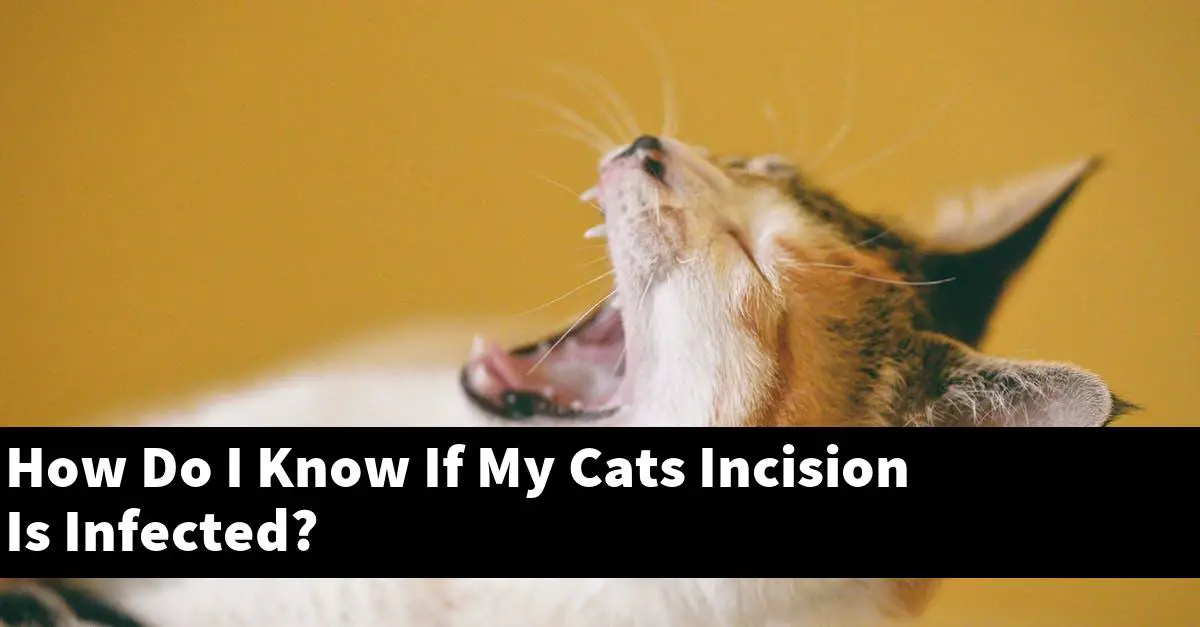An infection of a cat’s incision is a serious medical condition that can lead to death. If you notice any of the following signs, your cat’s incision may be infected and you should take them to the vet immediately: redness, swelling, heat, discharge, or pain.
How do you treat an infected incision on a cat?
It is important to properly clean and dry the incision site to prevent infection. Antibiotics and pain relief can be prescribed to help the cat heal.
If the incision is large, the veterinarian may need to suture the wound closed.
Is my cats incision healing normally?
The incision healing process is a gradual process and can take anywhere from two to six weeks. The most important thing to remember is to keep your cat comfortable and to provide plenty of coverage for the wound.
Some of the things you can do to help speed up the healing process include: applying a topical ointment, using a heating pad, providing a soft bed, and providing plenty of good food and water.
What should a healed cat incision look like?
A healed cat incision should be just a lines barely noticeable scar. The incision should be placed so that the hair on the back of the cat is not cut or pulled.
The incision should be placed on the back of the cat just below the shoulder blade.
How do you know if a spay incision is infected?
A spay incision is an incision made on a female dog’s reproductive tract to remove the ovaries and uterus. Infection with a microorganism such as bacteria, fungus, or virus can occur after surgery.
Signs of infection may include redness, swelling, and discharge from the incision site. If infection is suspected, the incision site should be examined by a veterinarian.
Treatment may include antibiotics and/or surgery to remove the infected tissue.
What does an infected cat wound look like?
An infected cat wound will typically be red and swollen, with a pus-like discharge. The wound may also be tender to the touch.
If left untreated, the wound can become infected, which can lead to sepsis (a life-threatening condition caused by infection).
How do you tell if a wound is healing or infected?
There are a few key things to look for when assessing a wound’s healing or infection status.
How do you treat an infected spay incision at home?
Infected spay incisions can be treated at home with antibiotics and pain relief. There is no need for surgery at home, and the incision can heal quickly.
What ointment can I put on a cat wound?
When caring for a cat with a wound, ointment is one of the most common items recommended. Ointments are available in a variety of forms, including creams, ointments, sprays, and gels.
They are available in many different brands, so it is important to choose one that is appropriate for the cat’s weight and skin type.
Ointments are typically applied to a cat’s wound twice a day, and should be reapplied if the wound dries out. Some ointments also have antimicrobial properties, so they may help to prevent infection.
What antiseptic can I use on my cat?
There are a few options for antiseptics that can be used on cats. A few of the more common ones include hydrogen peroxide, ethanol, isopropyl alcohol, and chlorhexidine.
All of these can be effective in killing bacteria and reducing the risk of infection. It is important to note that any antiseptic should be used in conjunction with proper ventilation and protection from contact with the eyes.
How can I treat my cat’s wound at home?
There are a few things that you can do to treat your cat’s wound at home. If the wound is small, you can try to clean the wound and apply a bandage.
If the wound is larger, you will need to take your cat to the veterinarian to be treated.
Conclusion
If you’re concerned that your cat’s incision may be infected, it’s important to monitor it closely and contact your veterinarian if you notice any redness, swelling, or discharge. Other signs of infection include lethargy, loss of appetite, and fever.
If you think your cat’s incision may be infected, don’t hesitate to reach out to your vet for guidance.


